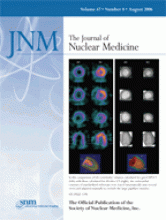REPLY: We greatly appreciate the thoughtful comments made by Professors Piepsz and Ham regarding the patient example and initial validation of RENEX, our expert system for detection of renal obstruction. We agree that it would be ideal to further validate RENEX using gold standards and parameters widely accepted by the entire medical community to detect renal obstruction. Nevertheless, the role of expert systems is to properly transfer the knowledge of the experts in a specific domain (such as detection of renal obstruction) to a computer program so that others with less expertise may use it to assist them to perform at the level of the experts. As such, what we are validating is that RENEX will reach the same conclusions about renal obstruction as would be reached by a typical nuclear medicine expert—that is, how well the transfer of knowledge took place. Professors Piepsz and Ham state that “the diagnosis of renal obstruction is a matter of continuous controversy” and make the appeal that introduction of RENEX into clinical practice should be delayed until all controversies surrounding detection of renal obstruction are resolved, including agreement on a gold standard. Professional competence has been defined as the ability to manage ambiguous problems, tolerate uncertainty, and make decisions based on limited information (1), and nuclear medicine physicians with various levels of expertise perform and interpret thousands of diuresis renography studies every year while these issues persist. Should we then make the appeal that diuresis renography studies not be performed clinically until the controversies in interpretation raised by Professors Piepsz and Ham are resolved? We should not demand more of an expert system than we expect from our own human experts.
In regard to the interpretation of the clinical study, Professors Piepsz and Ham argue that it is difficult to accept that both kidneys have reduced function. The camera-based 99mTc-mercaptoacetytriglycine (MAG3) clearance was 83 mL/min/1.73 m2. The normal camera-based MAG3 clearance is 321 ± 71 mL/min/1.73 m2, which is comparable to the normal MAG3 clearance based on plasma samples, 302 ± 73 mL/min/1.73 m2 (2,3). MAG3 clearance decreases with age and is estimated to decrease by 3.77 mL/min/1.73 m2 after age 40 (3); consequently, an 88-y-old person would be expected to have a reduced MAG3 clearance of approximately 121 mL/min/1.73 m2. The reduction in parenchymal function is supported by the fact that the cortical 20-min/maximum-count ratios were elevated for both kidneys, 0.47 for the right and 0.74 for the left (normal values are 0.19 ± 0.07 and 0.19 ± 0.04 for the right and left kidneys, respectively (2)). The cortical 20-min/maximum-count ratios are displayed in an expanded review of quantitative data; this display was available to the experts but was not reproduced in the RENEX paper for reasons of space (4).
Uptake was asymmetric between the left (54%) and right (46%) kidneys but was within normal limits. After furosemide, obstruction was excluded in the left kidney primarily by the rapid washout of the tracer from the left collecting system, as can be appreciated by inspection of the images. Calculation of the pelvic time to half-maximum counts in the left kidney was based on the first 5 min because no pelvic activity was detected after 5 min. The right kidney was determined to be obstructed because it markedly retained tracer after furosemide; moreover, the function of the 2 kidneys was similar, indicating that the right kidney could have responded to furosemide just as the left kidney responded if the right kidney had not been obstructed.
Neither the experts nor RENEX was aware of clinical data other than the sex, age, height, weight, and the fact that the patient was referred for suspected obstruction. (In the future, we plan to enhance the design of RENEX to incorporate clinical data.) We reviewed the clinical history and course of the patient. The patient presented with a 13.6-kg (30-lb) weight loss, an abdominal wall abscess, and a right upper quadrant mass. Her serum creatinine level was 1.1 mg/dL. Although this is a normal value, she had reduced muscle mass secondary to her weight loss, and serum creatinine may remain normal even when the glomerular filtration rate is reduced by as much as 60% (5). A CT scan showed a large pelvic mass suggestive of uterine leiomyosarcoma, a large necrotic right upper quadrant mass, and an abdominal wall abscess. Biopsy of the right upper quadrant mass revealed adenocarcinoma. A MAG3 scan was obtained because of concern regarding the patient's renal status. The MAG3 scan was interpreted as showing obstruction of the right kidney; a urology consult was obtained and a stent placed in the right ureter. At the completion of her hospital stay, the patient was discharged to hospice care.
Finally, Professors Piepsz and Hamm argue that an expert system used for the diagnosis of renal obstruction “should be based and validated on 2 series of patients with hydronephrosis, 1 corresponding to a simple dilatation, without any further renal deterioration, and 1 in which the conservative attitude resulted in kidney damage.” If Professors Piepsz and Hamm (or other investigators) have such a series, we would be glad to collaborate with them on transferring the data and processing it using our system.







